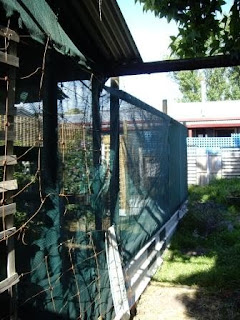No Dig Beds
In the front of my garden and in the back I have improved the soil and created raised beds using the No Dig Method developed by Esther Dean in the 1970's in Sydney.
It's fairly easy to build a No-Dig bed and try to use materials already in your garden.
I am fortunate enough to have a beautiful Liquid Amber in my back garden , a large deciduous tree that produces a mountain of leaves every autumn. So the bulk of the organic matter comes from the tree.
It is important when building a No-Dig Bed to try and use a variety of materials, this makes for better soil.

This garden bed was built using eco timber a pine not treated with arsenic, but a non-poisonous treatment. Some of my garden beds are made using treated pine, but because I have a very healthy soil and lots of bio-active compost full of fungi and microbes and am aware that they will 'lock' up the heavy metals in the soil and make them unavailable to plants and therefore me.
As you can see in the garden bed, it is full of straight kitchen scraps grass and other organic material.

I then top with a layer of composted mixed manure from Mr Poo, then straw that has been shredded by my 'gals' in the chook house and added with extra nutrients.
How to build a No-Dig Bed
Step 1
Mark out the area and edge it with bricks or any material that will contain the soil when it is built. Four square metres is a good size to start, but this can be expanded later.
Step 2
Cover the entire area with wads of newspaper a good 'herald sun' thick to smother any weeds. Overlap the pages so there are no gaps for weeds to grow through, and avoid using as much coloured print as possible. Water the area newspaper well so that it starts breaking down immediately. I find cardboard is a good barrier too. DO NOT do this on a windy day or you will be driven mad with the blowing paper.
Step 3
Cover the area with high carbon organic matter, which will break down easily. This could be by pea-straw or crop-straw like rye or canola, grass, leaves whatever is cheap and available. Crop-straw is usually less expensive than lucerne or pea-straw, but is lower in nitrogen. Water the matter lightly.
Step 4
Next apply a layer of organic fertiliser. Chicken manure is excellent because it has high amounts of nitrogen, which helps the breakdown high carbon materials, but any farm manure will perform the function.
Step 5
Add a 20-centimetre layer of high carbon material.
Step 6
Add another layer of manure and again water lightly. Of course you can create as many layers as you like.
Step 7
Finally, you will need some good compost to plant the seeds and seedlings into. If there is enough available, the whole surface area of the garden could be covered with compost to about 10 cm. Alternatively pockets of compost can be created for planting so that it can support a new plant while the new garden is breaking down.

The same has been done out the front, but in a more free form way.
 The potatoes in this bed just appeared, I might of chucked some old ones in from the cupboard that were starting to shoot, and I think that is a russian garlic growing through the middle. You can just make out the globe artichoke at the back.
The potatoes in this bed just appeared, I might of chucked some old ones in from the cupboard that were starting to shoot, and I think that is a russian garlic growing through the middle. You can just make out the globe artichoke at the back.  This bed is garlic, two sorts the giant russian garlic that was given to me by a lady who claims it has been passed down four generations of her family. The rest is some garlic I bought from green harvest about 5 years ago and it is still going. Behind that bed is some
This bed is garlic, two sorts the giant russian garlic that was given to me by a lady who claims it has been passed down four generations of her family. The rest is some garlic I bought from green harvest about 5 years ago and it is still going. Behind that bed is some













